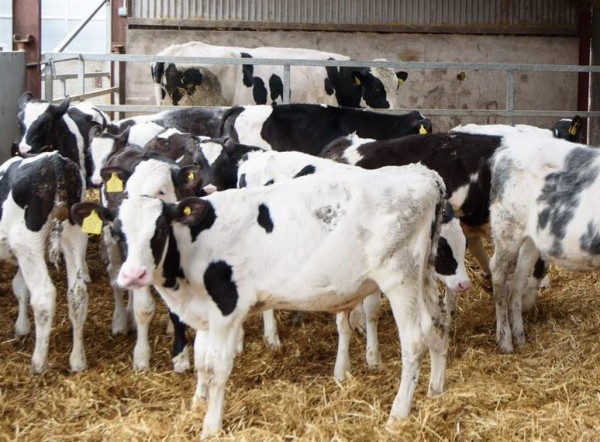Calf health essential for long-term profits
For long-term profitability, good calf health is essential. In January, we co-hosted the ‘Calf Rearing: Steps to success for improved calf health’ event along with Animal Health Ireland and Teagasc.
Although conditions were difficult in early January, many farmers have succeeded in getting grass into cows without causing permanent damaged to their paddocks.
MANAGEMENT OF SCOUR
What causes calf scour?
- Parasites – Cryptosporidia and Coccidia (generally in calves >3 weeks)
- Viruses – Rotavirus and Coronavirus
- Bacteria – Salmonella and E. coli (only in calves <5 days of age)
How do I get a diagnosis?
- Submit faecal samples (taken from the calf not the floor) from untreated scouring calves (in sterile containers) in the early stages of a disease outbreak to your vet
Treatment
- Remove: Isolate the calf to prevent spread of infection and aid recovery
- Rehydrate: Rehydrate by giving oral fluids. Healthy calves need a minimum of 4 litres of fluid a day and scouring calves need an additional 4 litres to replace lost fluids. These should be given separately from the milk feeds. It is safe to give these fluids by stomach tube.
- Feed Milk: Continue to offer scouring calves normal amounts of milk or milk replacer as long as they want to drink. Do not feed diluted milk to calves. Continue to feed with milk or good quality milk replacer as it does not cause, worsen or prolong scour. Milk or milk replacer should not be stomach-tubed.
- Antibiotics don’t work against parasites and viruses. However, they should be used by injection form only, if the calf is very sick, or if it has a temperature outside of the normal range; 38.5 to 39.5°C
Prevention is key
- Maximise immunity. Ensure colostrum management is excellent – ensure calf gets 3L of high-quality colostrum in the first 2 hours of life, do not leave this to chance
- Maintain strict standards of hygiene throughout calf rearing; this includes the calving pen, calf pens and feeding equipment; provide adequate bedding and replace regularly
CALF ACCOMODATION
The basic principles of calf accommodation are summarised as follows:
- The young calf will spend up to 80% of its time lying down so a dry bed is essential
- A minimum floor fall of 1 in 20 is required. Place water bowls and feeders at the lower end of the sloped floor to ensure that the bedding remains dry
- Allow a total floor space of 1.5 square metres/calf
- Teagasc research with rearing calves outdoors in such shelters from 4-5 weeks of age found no difference in calf daily liveweight gain compared to calves reared indoors. Check the forecast and make sure that calves are turned out when a few dry days are forecast
- Concrete is one of the coldest surfaces a calf can lie on therefore it is imperative that calves have a good thick bed of clean dry straw underneath them and at least 3 inches above the floor
JOHNE’S DISEASE: UNDERSTANDING THE RISKS AND IDENTIFYING THE SOLUTIONS
Johne’s disease causes a loss of production, reduced fertility, weight loss, or increased culling rates. There is no cure for the disease and current control methods focus on the removal of test-positive animals from a herd, preventing the introduction of infection and managing calves to avoid contact with potentially infected dung.
- Cows should be clean prior to entering the calving pens
- Remove all calves soon after birth, ideally within 15 minutes
PREPARING AND HANDLING CALVES FOR TRANSPORT
Calves destined for sale must be given the same standard of care as every other calf on the farm.
Good on-farm management is essential as calves that are well cared for prior to transportation are more likely to be fit on arrival. All calves must:
- Be fed colostrum (Follow the 1-2-3 rule; first feed within 2 hours of birth, feed 3 litres of colostrum)
- Be fed twice daily with adequate milk or milk replacer and have free access to water at all times
- Have protection from excess wind and rain and are kept clean and dry with bedding
- Be handled gently at all times Lift calves with one arm in front of the calf ’s front legs and the other either in front of or between the calf ’s back legs. Get help to lift heavy calves

